The Intel Comet Lake Core i9-10900K, i7-10700K, i5-10600K CPU Review: Skylake We Go Again
by Dr. Ian Cutress on May 20, 2020 9:00 AM EST- Posted in
- CPUs
- Intel
- Skylake
- 14nm
- Z490
- 10th Gen Core
- Comet Lake
Core-to-Core Latency: Issues with the Core i5
For Intel’s Comet Late 10th Gen Core parts, the company is creating two different silicon dies for most of the processor lines: one with 10 cores and one with 6 cores. In order to create the 8 and 4 core parts, different cores will be disabled. This isn’t anything new, and has happened for the best part of a decade across both AMD and Intel in order to minimize the number of new silicon designs, and also to build in a bit of redundancy into the silicon and enable most of the wafer to be sold even if defects are found.
For Comet Lake, Intel is splitting the silicon such that all 10-core Core i9 and 8-core Core i7 processors are built from the 10c die, as is perhaps expected, and the 6-core Core i5 and 4-core Core i3 processors are built from the 6c die. The only exception to these rules are the Core i5-10600K/KF processors which will use the 10-core die with four cores disabled, giving six cores total. This leads to a potential issue.
So imagine a 10c die as two columns of five cores, capped on each end by the System Agent (DRAM, IO) and Graphics, creating a ring of 12 stops that data has to go through to reach other parts of the silicon. Let us start simple, and imagine disabling two cores to make an 8c processor. It can be pretty straightforward to guess the best/worst case scenario in order to get the best/worst core-to-core latency
The other worst 8c case might be to keep Core 0 enabled, and then disable Core 1 and Core 2, leaving Core 3-9 enabled.
We can then disable four cores from the original 10 core setup. It can be any four cores, so imagine another worst case and a best case scenario.
On the left we have the absolute best case arrangement that minimizes all core-to-core latency. In the middle is the absolute worst case, with any contact to the first core in the top left being a lot higher latency with more distance to travel from any core. On the right is an unbalanced design, but perhaps a lower variance in latency.
When Intel disables cores to create these 8c and 6c designs, the company has in the past promised that any disabling would leave the rest of the processor ‘with similar performance targets’, and that while different individual units might have different cores disabled, they should all fall within a reasonable spectrum.
So let us start with our Core i5-10600K core-to-core latency chart.
Cores next door seem well enough, then as we make longer trips around the ring, it takes about 1 nanosecond longer for each stop. Until those last two cores that is, where we get a sudden 4 nanosecond jump. It’s clear that the processor we have here as a whole is lopsided in its core-to-core latency and if any thread gets put onto those two cores at the end, there might be some questionable performance.
Now it’s very easy to perhaps get a bit heated with this result. Unfortunately we don’t have an ‘ideal’ 6c design to compare it against, which makes comparisons on performance to be a bit tricky. But it does mean that there is likely to be variation between different Core i5-10600K samples.
The effect still occurs on the 8-core Core i7-10700K, however it is less pronounced.
There’s still a sizeable jump between the 3 cores at the end compared to the other five cores. One of the unfortunate downsides with the test is that the enumeration of the cores won’t correspond to any physical location, so it might be difficult to narrow down the exact layout of the chip.
Moving up to the big 10-core processor yields an interesting result:
So while we should have a steadily increasing latency here, there’s still that 3-4 nanosecond jump with two of the cores. This points to a different but compounding issue.
Our best guess is that these two extra cores are not optimized for this sort of ring design in Comet Lake. For their Core lineup of processors, Intel has been using a ring bus as the principle interconnect between its cores for over a decade, and we typically see them on four and six core processors. Intel also used a ring bus in its enterprise processors for many years, with chips up to 24 cores, however those designs used dual-ring buses in order to keep core-to-core latency down. Intel has put up to 12 cores on a single ring, though broadly speaking the company seems to prefer keeping designs to 8 or fewer cores per ring.
If Intel could do it for those enterprise chips, then why not for the 10 core Comet Lake designs here? We suspect it is because the original ring design that went into consumer Skylake processors, while it was for four cores, doesn’t scale linearly as the core count increases. There is a noticeable increase in the latency as we move from four to six and six to eight core silicon designs, but a ten-core ring is just a step too far, and additional repeaters are required in the ring in order to support the larger size.
There could also be an explanation relating to these cores also having additional function on that section of the ring, such as sharing duties with IO parts of the core, or PCIe lanes, and as a result extra cycles are required for any additional cacheline transfers.
We are realistically reaching the limits of any ring-line interconnect for Intel’s Skylake consumer line processors here. If Intel were to create a 12-core version of Skylake consumer for a future processor, a single ring interconnect won’t be able to handle it without an additional latency penalty, which might be more of a penalty if the ring isn't tuned for the size. There's also a bandwidth issue, as the same ring and memory has to support more cores. If Intel continue down this path, they will either have to use dual rings, use a different interconnect paradigm altogether (mesh, chiplet), or move to a new microarchitecture and interconnect design completely.
Frequency Ramps
We also performed our frequency ramps on all three processors. Nothing much to say here – all three CPUs went from 800 MHz idle to peak frequency in 16 milliseconds, or one frame at 60 Hz. We saw the peak turbo speeds on all the parts.


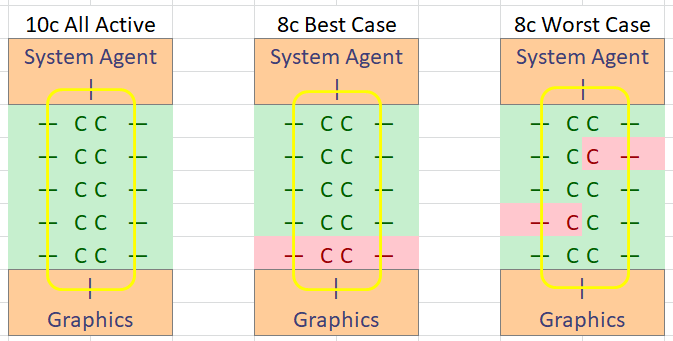
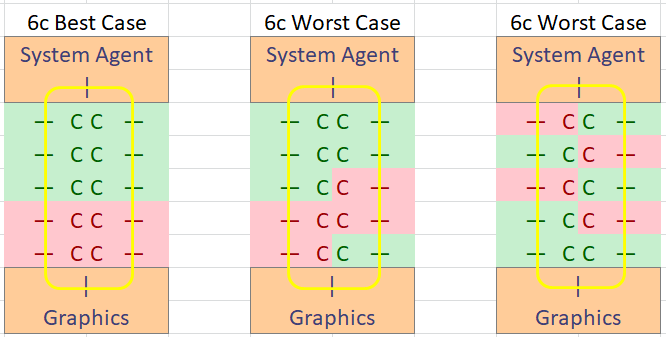
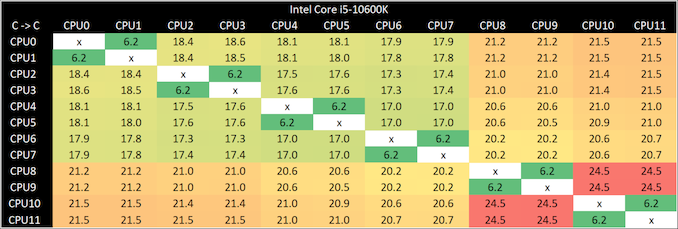



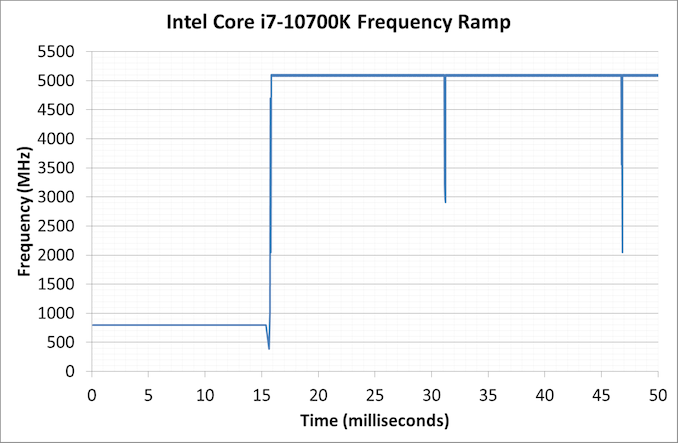
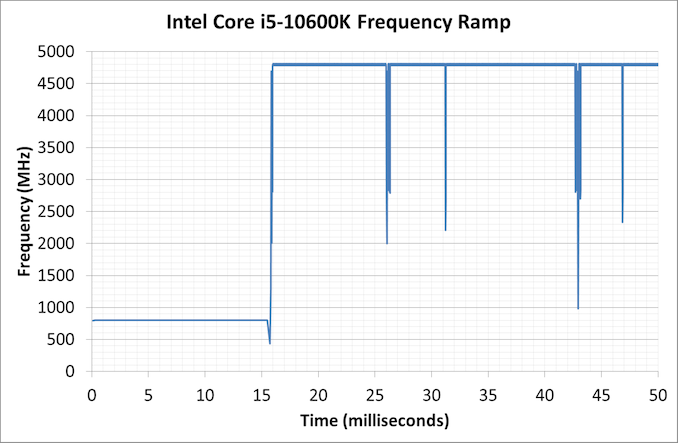








220 Comments
View All Comments
Boshum - Wednesday, May 20, 2020 - link
Pfft. You are hilarious.Spunjji - Tuesday, May 26, 2020 - link
Maxipad, the latest in the line of Gondalf imitators.Adm_SkyWalker - Wednesday, May 20, 2020 - link
Once again I find myself debating if I should upgrade. My current i7-6950X has held up better than I thought it would. I guess it's another year or two wait for me.Boshum - Wednesday, May 20, 2020 - link
I would be good with a beast like that for 5 more years.Icehawk - Saturday, May 23, 2020 - link
I’d wait until a component like mobo dies, that’s what got me to move from a 3770 about a year ago to a 8700 - mobo died and they were pricy and old. Replaced my wife’s i5 from same gen with a 3900X though recently and gave her the intel box. I’m a gamer but I do a lot of encoding so felt AMD offered a better mix and allows me to use my 450W fanless PSU. But aside from encoding speed I barely notice a difference from that 3700.Dug - Wednesday, May 20, 2020 - link
The problem with all these charts is that they are inconsistent.There are so many variables that aren't shown that it doesn't make sense to show these.
Most of this has to do with how motherboards handle the cpu's and what their default settings do.
There can be a 15% swing in AMD motherboard default settings between brands. Not to mention things like pbo on or off, infinity fabric, memory timings, etc.
I don't know about the Intel side. I remember their settings made less difference unless it was just cpu clock speed.
shady28 - Wednesday, May 20, 2020 - link
Agree with the sentiment, but you kinda stacked the deck with that last statement.Most of the Z490s are now supporting much higher speed RAM (up to DDR4-5000) and even intel 9th gen were good at overclocked RAM, while AMD systems rarely get above 3600Mhz. It shows if you look at something like PCMark 10 where the top 100 systems on almost all of the charts is completely dominated by intel. All of them are overclocked of course, but all of the top AMD systems are also overclocked.
What I would like to see is something along the lines of a i5-10600K vs AMD 3600 vs AMD 3600X, but not using 'all the same components other than mobo and CPU'. Take those 3 chips and build the fastest system you can with them. Use that PCI 4.0 NVMe and GPU on AMD, use that 4800Mhz CAS 18 RAM on the Intel. See what happens.
mrvco - Wednesday, May 20, 2020 - link
Ok, part of me would be curious to see what Intel could (or couldn't) do with an 11th Gen spin of their 14nm process.Findecanor - Wednesday, May 20, 2020 - link
The "Security" portion of this article is not really comprehensible. I can't guess what the author is thinking. The author needs to write it down in actual words what these things mean.Security on Intel processors is what is holding me off from buying any Intel CPU for the time being.
I consider myself pretty knowledgeable about the actual vulnerabilities themselves, and how they work, and how they can be mitigated -- in theory --, but if I have not kept up with every little tidbit of news about security on Intel's processors in particular, that portion of the article tells me absolutely NOTHING.
quadibloc - Wednesday, May 20, 2020 - link
These chips are impressive, and for people with a need to build a system today, and a preference for Intel, they are reasonably competitive. So I am favorably impressed, even if AMD would remain my own choice at the moment. I still do believe that in the long run, Intel does have the means to regain leadership, so that in a year or two or five, AMD will be back to being in second place (but in second place like the previous generations of Ryzens, not like the Bulldozer years). I don't know, though, if even Intel will be able to keep up at the process end; even it may have to go fabless after 10nm, which would have significant implications for the industry.